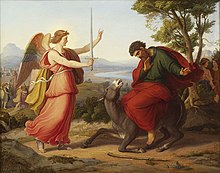Purismo
Purismo was an Italian cultural movement which began in the 1820s. The group intended to restore and preserve language through the study of medieval authors, and such study extended to the visual arts.
Inspired by the
History

The term "Purismo" was coined in 1838 to describe the paintings of
The group's ideals were declared in their manifesto Del purismo nelle arti, in 1842–43 which was written by Antonio Bianchini and co-signed by major proponent of Purismo Tommaso Minardi (1787–1871), Nazarene co-founder Friedrich Overbeck, and sculptor Pietro Tenerani.
Another important support of Purismo was
Maurizio Dufou was the main Purismo proponent in Liguria; he was joined by artists such as Luigia Mussini Piaggio. In Genoa, the largest realization of the movement's style is the Basilica di Santa Maria Immacolata.
With the first national Italian exhibition in 1861, which took place in Florence, the fortunes of Purismo began to decline and be replaced by the styles of Verismo and the Macchiaioli.
References
